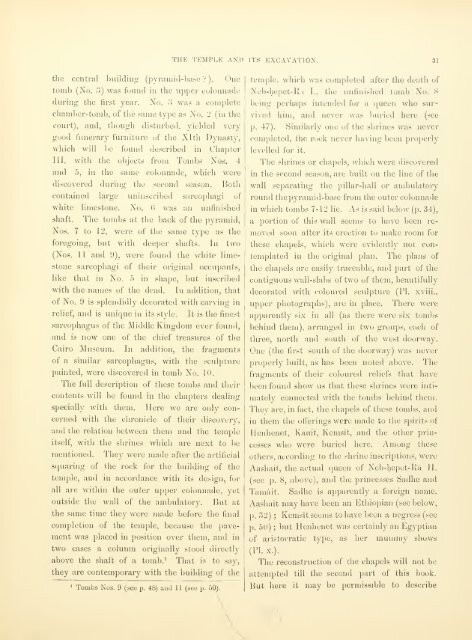The XIth dynasty temple at Deir el-Bahari .. - NYU | Digital Library ...
The XIth dynasty temple at Deir el-Bahari .. - NYU | Digital Library ...
The XIth dynasty temple at Deir el-Bahari .. - NYU | Digital Library ...
You also want an ePaper? Increase the reach of your titles
YUMPU automatically turns print PDFs into web optimized ePapers that Google loves.
the central luiililinn- (pyramid-base?). One<br />
tomb (No. 3) was found ia the upper colonnade<br />
during the first year. No. 3 was a complete<br />
cliamber-tomb, of tlie ^^ame type as No. 2 (in the<br />
court), and, thoufili disturbed, yi<strong>el</strong>ded very<br />
good funerary furniture of the Xltli Dynasty,<br />
which will lie ri)tiiiil described in Chapter<br />
Ml. with the objects from TdUibs Xos. 4<br />
and .'), in the same colonnade, which were<br />
discovered during the second season. Both<br />
contained large uninscribed sarcophagi of<br />
white limestone. So. 6 was an unlinished<br />
shaft. <strong>The</strong> tondjs <strong>at</strong> the back of the pyramid,<br />
Nos. 7 to li', were of the same type as the<br />
foregoing, but with deeper shafts. In two<br />
(Nos. 11 and !)), were found the Avhite lime-<br />
stone sarco^ihagi of their original occupants,<br />
like th<strong>at</strong> in No. 5 in shape, but inscribed<br />
with the names of the dead. In addition, th<strong>at</strong><br />
of No. 9 is splendidly decor<strong>at</strong>ed with carving in<br />
r<strong>el</strong>ief, and is unique in its style. It is the finest<br />
sarcophagus of the ^Middle Kingdom ever found,<br />
and is now one of the chief treasures of the<br />
Cairo Museum. In addition, the fragments<br />
of a similar sarcophagus, with the sculpture<br />
painted, were discovered in tomb No. 10.<br />
<strong>The</strong> full description of these tombs and their<br />
contents will be found in the chapters dealing<br />
specially with them. Here we are only con-<br />
cerned with the chronicle of their discovery,<br />
and tlie r<strong>el</strong><strong>at</strong>ion between them and the <strong>temple</strong><br />
its<strong>el</strong>f, with the shrines which arc next to be<br />
mentioned. <strong>The</strong>y were made after the artificial<br />
squaring of the rock for the building of the<br />
<strong>temple</strong>, and in accordance with its design, for<br />
all are within the outer upper colonnade, yet<br />
outside the wall of tlie ambul<strong>at</strong>ory. But <strong>at</strong><br />
the same time they were made before the final<br />
completion of the <strong>temple</strong>, because the j)avcment<br />
was placed in position over them, and in<br />
two cases a column originally stood directly<br />
above the shaft of a tomb.' Th<strong>at</strong> is to say,<br />
they are contemporary with the building of the<br />
' Tombs Nos. 9 (see p. 48) and 11 (see p. 50).<br />
THE TEMPLE AND ITS EXCAVATION. 31<br />
<strong>temple</strong>, which was completed after the de<strong>at</strong>h of<br />
Neb-liepet-R I I., the unfinished tomb No. 8<br />
being perhaps intended for a queen who sur-<br />
vived him, and never was buried here (see<br />
p. 47). Similarly one of the shrines was never<br />
completed, the rock never having been properly<br />
lev<strong>el</strong>led for it.<br />
<strong>The</strong> shrines or chap<strong>el</strong>s, which were discovered<br />
in the second season, are built on the line of the<br />
wall separ<strong>at</strong>ing the pillar-hall or ambul<strong>at</strong>ory<br />
round the pyramid-base from the outer colonnade<br />
in which tombs 7-12 lie. As is said b<strong>el</strong>ow (p. '64.),<br />
a portion of this wall seems to have been removed<br />
soon after its erection to make room for<br />
these chap<strong>el</strong>s, which were evidently not con-<br />
templ<strong>at</strong>ed in the original plan. <strong>The</strong> plans of<br />
the chap<strong>el</strong>s are easily traceable, and part of the<br />
contiguous wall-slabs of two of them, beautifully<br />
decor<strong>at</strong>ed with coloured sculpture (PI. xviii.,<br />
upper photographs), are in place. <strong>The</strong>re were<br />
apparently six in all (as there were si.x tombs<br />
behind them), arranged in two groups, each of<br />
three, north and south of the west doorway.<br />
One (the first south of the doorway) was never<br />
properly built, as has been noted above. <strong>The</strong><br />
fragments of their coloured r<strong>el</strong>iefs th<strong>at</strong> have<br />
been found show us th<strong>at</strong> these shrines were inti-<br />
m<strong>at</strong><strong>el</strong>y connected with the tombs behind them.<br />
<strong>The</strong>y are, in fact, the chajs<strong>el</strong>s of these tombs, and<br />
in them the ofi'erings were made to the spirits of<br />
Henhenet, Kauit, Kemsit, and the other jjrin-<br />
cesses who were buried here. Among these<br />
others, according to the shrine inscriptions, were<br />
Aashait, the actual queen of Neb-liepet-Rii II.<br />
(see p. 8, above), and the princesses Sadhe and<br />
Tamait. Sadhe is apparently a foreign name.<br />
Aashait may have been an Ethiopian (see b<strong>el</strong>ow,<br />
p. .32) ;<br />
p. 50)<br />
Kemsit seems to have been a negress (see<br />
; but Henhenet was certainly an Egyptian<br />
of aristocr<strong>at</strong>ic type, as her mummy shows<br />
(PI. X.).<br />
<strong>The</strong> reconstruction of the chap<strong>el</strong>s will not be<br />
<strong>at</strong>tempted till the second part of this book.<br />
But here it may be permissible to describe<br />
•A'

















